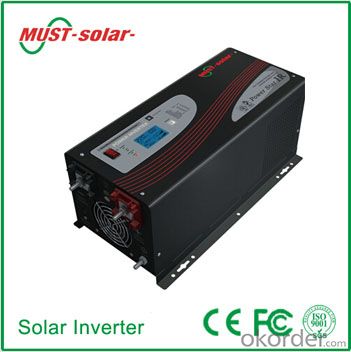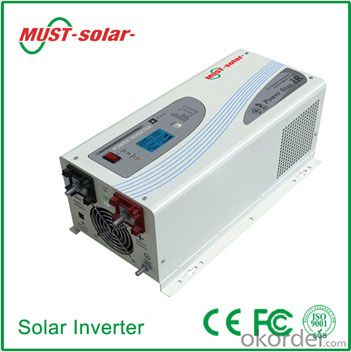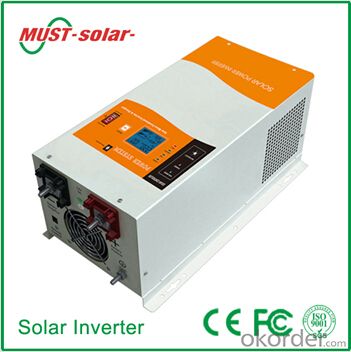Off-Grid Low Frequency PV Inverter EP3200 Series 4KW-6KW
- Loading Port:
- China main port
- Payment Terms:
- TT or LC
- Min Order Qty:
- 50 unit
- Supply Capability:
- 1000 unit/month
OKorder Service Pledge
OKorder Financial Service
You Might Also Like
1. Structure of Off-Grid Low Frequency PV Inverter Description
EP3200 series off-grid low frequency PV inverter adopt very new model copper transformer so the efficiency reach to 90% and lower
consumption (NEW !)
Pure sine wave solar hybrid inverter for solar system and home appliances . EP3200 series off-grid low frequency PV inverter developed on
the base of our very popular EP3000 series . EP3200 has achieved significant improvements on battery charging , AC transfer , bypass
etc .
By adopting DIP(Dual-in-line) switch , EP3200 series off-grid low frequency PV inverter provides more smarter options for users to
customize the performance of the device . Main for home solar system including air conditioner , refrigerator , washing machine , water
pump , fans , tv , lights etc.
2. Main Features of the Off-Grid Low Frequency PV Inverter
• High overload ability of our EP3200 charger is up to 300% rated power
• EP3200 pure sine wave inverter adopts low quiescent current, and power saver mode to reduce power consumption to 3W . It can extract
max. power from various batteries with different protections, and low voltage trip can be selected (10V/10.5V/11V).
• Uses PFC (power factor correction) for charger, which has less power consumption than conventional units.
• It has 10s delay before transfer when AC resumes, and overload protection when our APC pure sine wave inverter equips with generator.
• 10ms typical transfer time between battery and AC, which guarantees power continuity of EP3200 charger. Uses selectable input AC
voltage (185-265V or 155-255V) for different kinds of loads.
• Our EP3200 charger allows start up and through power with depleted batteries. Its powerful charge rate up to 70Amp.
• It can offer 3-step intelligent battery charging, and equipped with 6 preset battery type selector for totally flat batteries.
• LCD status display, battery/AC priority switch, RS232 communication port are available for our EP3200 pure sine wave inverter, it also
has 17 alarms/warnings for easier operation and trouble-shooting, and ability to switch the unit on/off. In addition, select/deselect power
saver mode can be used too.
3. Off-Grid Low Frequency PV Inverter Images




4. Off-Grid Low Frequency PV Inverter Specification
Rated Capacity | 4000W | 5000W | 6000W | |
Efficiency | >90% | |||
Input | ||||
Model | 120v Models | 230v Models | ||
Nominal Voltage | 100V/110V/115V/120VSelectable | 200V/220V/230V/240V Selectable | ||
Output | ||||
Rated Power | 4000W | 5000W | 6000W | |
Output Voltage | 100V/110V/115V/120V Selectable | 200V/220V/230V/240V Selectable | ||
Voltage Waveform | Pure Sine Wave | |||
Crest Factor | 3:01 | |||
Transfer Time | Transfer Time : AC To DC : 10ms (Typical) | |||
Transfer Time : DC To AC : 10ms(Typical ) | ||||
Max Bypass | 30A | |||
Overload Current | ||||
Input | ||||
Nominal Voltage | DC24V/48V | DC48V | DC48V | |
Over Current Protection | By Re-Settable Over Current Protector | |||
Output | ||||
Regulation (Nominal) | ±10% Typical Of Nominal Voltage | |||
Nominal Input Voltage | 230Vac | |||
Input Voltage Range | 185-265Vac | |||
Nominal Output Voltage | According To The Battery Type | |||
Nominal Charge Current | 30Amp-70Amp | |||
Battery Type | Lead-Acid 12Ah ~ 250Ah | |||
Typical Backup Time | No Limit | |||
Charging Method | Smart Pulse Charging With Two Charging Modes: | |||
Quick Charging When Battery Is Not Fully Charged, | ||||
Trickle Charging When Battery Is 90% Fully Charged. | ||||
Average Charging | 65A/35A | 70A/40A | 50A | |
Current | ||||
Battery Voltage options | ||||
Options 7 | Battery low trip to bypass 11v , high trip to battery 14v | |||
Options 8 | Battery low trip to bypass 10.5v , high trip to battery 13.5v | |||
Options 9 | Battery low trip to bypass 10v , high trip to battery 13v | |||
Communications & Management | ||||
Control Panel | LCD/LED Option | |||
Audible Alarm | Alarm On Battery: | |||
Low Battery & Battery Over Voltage | ||||
Alarm On Abnormal Operation: | ||||
Over Load, Short-Circuit, & Over Heat | ||||
Environment And Safe | ||||
Operating | 0℃ To 40℃ (32℉ To 104℉) | |||
Temperature | ||||
Transit/Storage | -15℃ To 60℃ | |||
Temperature | ||||
Audible Noise | 60 Dba Max at 1m | |||
Quality Control System | ISO 9001,FCC,CE | |||
Physical | ||||
Dimensions: (H×D×W) | 755*320*310mm | |||
G.W (Kg) | 37.5 | 47.5 | 47.5 | |
Packing | Export Carton For Each Unit Per Carton | |||
5. FAQ of Off-Grid Low Frequency PV Inverter
Q1. What is the difference between inverter and Off-Grid Low Frequency PV Inverter?
A1. Inverter only has AC inpput, but Off-Grid Low Frequency PV Inverter both connect to AC input and solar panel, it saves more power.
Q2. What is the difference between MPPT&PWM?
A2. MPPT has higher efficiency, it can track the max power point and won't waste energy.
Q3. What is the waranty of product?
A3. 12 months.
- Q:What is the difference between a transformerless inverter and a transformer-based inverter?
- A transformerless inverter does not include a transformer in its design, while a transformer-based inverter incorporates a transformer as an integral component. The main difference lies in their electrical isolation capabilities and overall system efficiency. Transformerless inverters use circuitry to achieve electrical isolation, which can result in higher efficiency and reduced size. On the other hand, transformer-based inverters employ a physical transformer for isolation, which offers better safety and protection against electrical noise and voltage fluctuations.
- Q:Can a solar inverter be controlled remotely?
- Indeed, remote control of a solar inverter is possible. Numerous contemporary solar inverters are furnished with integrated communication capabilities like Wi-Fi or Ethernet connectivity, granting the ability to monitor and control them from a distance. Users can access and manage their solar inverters from any location with an internet connection through a web-based interface or a dedicated mobile app. The remote control features typically encompass performance monitoring, settings adjustment, and issue troubleshooting. This remote control functionality provides solar system owners with convenience and flexibility, empowering them to maximize energy production and efficiently manage their systems.
- Q:What is the maximum AC output power of a solar inverter?
- The maximum AC output power of a solar inverter is determined by its capacity and specifications, but it typically ranges from a few hundred watts to several kilowatts.
- Q:Can a solar inverter be used in regions with extreme weather conditions?
- Yes, a solar inverter can be used in regions with extreme weather conditions. However, it is important to choose an inverter that is designed and rated for the specific weather conditions of that region. For example, there are solar inverters available that are built to withstand high temperatures, extreme cold, humidity, and even harsh weather events such as hurricanes. It is crucial to consider the environmental factors and select an inverter that is suitable for the specific climate conditions to ensure optimal performance and longevity.
- Q:Can a solar inverter be used in areas with high levels of electromagnetic interference (EMI)?
- Yes, a solar inverter can be used in areas with high levels of electromagnetic interference (EMI) as long as it is properly shielded and designed to withstand such conditions. However, it is important to choose an inverter that meets the necessary EMI compliance standards to ensure reliable and efficient operation in these environments.
- Q:What is the role of capacitors in a solar inverter?
- The role of capacitors in a solar inverter is to store and release electrical energy, helping to stabilize the voltage and provide smooth and continuous power output. Capacitors in a solar inverter also assist in filtering out any unwanted electrical noise or interference, ensuring the efficient and reliable operation of the inverter.
- Q:How does a solar inverter handle frequency fluctuations in the grid?
- A solar inverter handles frequency fluctuations in the grid by continuously monitoring the frequency of the grid and adjusting its output accordingly. If the grid frequency increases, the inverter reduces its output, and if the grid frequency decreases, the inverter increases its output. This helps to stabilize the grid frequency and maintain a balanced power supply.
- Q:What is the maximum input voltage for a solar inverter?
- The maximum input voltage for a solar inverter typically depends on the specific model and manufacturer. However, in general, solar inverters are designed to handle input voltages ranging from around 250 to 600 volts.
- Q:How does a solar inverter handle islanding detection and prevention?
- A solar inverter handles islanding detection and prevention by continuously monitoring the electrical grid. If the solar inverter detects a disturbance or a loss of grid power, it immediately stops injecting power into the grid. This action helps prevent the formation of an island, where a portion of the grid remains energized by the solar inverter while the main grid is down. By actively monitoring and ceasing power injection during grid abnormalities, a solar inverter ensures the safety of utility workers and prevents potential equipment damage.
- Q:Can a solar inverter be used with a solar-powered educational system?
- Yes, a solar inverter can be used with a solar-powered educational system. A solar inverter is responsible for converting the direct current (DC) produced by solar panels into alternating current (AC) that can be used to power electrical devices. In the case of a solar-powered educational system, the solar inverter plays a crucial role in converting the DC energy generated by the solar panels to AC energy that can be utilized by the educational equipment, such as computers, projectors, or other electrical devices, thereby enabling the system to function efficiently.
1. Manufacturer Overview |
|
|---|---|
| Location | |
| Year Established | |
| Annual Output Value | |
| Main Markets | |
| Company Certifications | |
2. Manufacturer Certificates |
|
|---|---|
| a) Certification Name | |
| Range | |
| Reference | |
| Validity Period | |
3. Manufacturer Capability |
|
|---|---|
| a)Trade Capacity | |
| Nearest Port | |
| Export Percentage | |
| No.of Employees in Trade Department | |
| Language Spoken: | |
| b)Factory Information | |
| Factory Size: | |
| No. of Production Lines | |
| Contract Manufacturing | |
| Product Price Range | |
Send your message to us
Off-Grid Low Frequency PV Inverter EP3200 Series 4KW-6KW
- Loading Port:
- China main port
- Payment Terms:
- TT or LC
- Min Order Qty:
- 50 unit
- Supply Capability:
- 1000 unit/month
OKorder Service Pledge
OKorder Financial Service
Similar products
New products
Hot products
Hot Searches
Related keywords
































